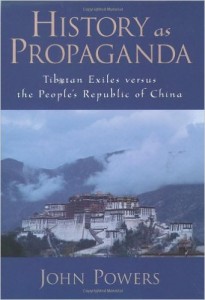 In History as Propaganda: Tibetan Exiles versus the People’s Republic of China, John Powers surveys a wide variety of histories of Tibet, written by Tibetan, Chinese, and western (i.e., American or European) authors. The story of the relations between China and Tibet — is Tibet an independent state or merely a small part of China’s empire? — can be told in many different ways, depending on the interests or agenda of the author spinning the narrative. Of particular interest to me is how Powers notes the normative vocabulary of the historians he surveys. The authors tend to systematically use normative nouns and adjectives — with positive and negative valuations attached to them — in their narratives. See the following two tables: Continue reading “On the Systematic Use of Normative Vocabulary”
In History as Propaganda: Tibetan Exiles versus the People’s Republic of China, John Powers surveys a wide variety of histories of Tibet, written by Tibetan, Chinese, and western (i.e., American or European) authors. The story of the relations between China and Tibet — is Tibet an independent state or merely a small part of China’s empire? — can be told in many different ways, depending on the interests or agenda of the author spinning the narrative. Of particular interest to me is how Powers notes the normative vocabulary of the historians he surveys. The authors tend to systematically use normative nouns and adjectives — with positive and negative valuations attached to them — in their narratives. See the following two tables: Continue reading “On the Systematic Use of Normative Vocabulary”
Just a few Notes
 Know that image? It’s from the once popular Disney movie “The AristoCats” (1970) — take a look at the scene: Continue reading “Just a few Notes”
Know that image? It’s from the once popular Disney movie “The AristoCats” (1970) — take a look at the scene: Continue reading “Just a few Notes”
Code Switching in the Funny Papers
 This morning on National Public Radio, there was a story on a cross-cultural comic book superhero…. Continue reading “Code Switching in the Funny Papers”
This morning on National Public Radio, there was a story on a cross-cultural comic book superhero…. Continue reading “Code Switching in the Funny Papers”
Whose Culture?
 The New York Times headline Sunday “In China, ‘Once the Village is Gone, The Culture is Gone’” certainly grabbed my attention for its construction of “China” and “culture”. The article and accompanying video decry the loss of villages across China due to urbanization. While many migrate for jobs, some are forced to leave their village due to development plans. Since the state owns the land, the government can force people to move to make room for proposed developments, a golf course in this example. Continue reading “Whose Culture?”
The New York Times headline Sunday “In China, ‘Once the Village is Gone, The Culture is Gone’” certainly grabbed my attention for its construction of “China” and “culture”. The article and accompanying video decry the loss of villages across China due to urbanization. While many migrate for jobs, some are forced to leave their village due to development plans. Since the state owns the land, the government can force people to move to make room for proposed developments, a golf course in this example. Continue reading “Whose Culture?”
The Persistence of Belief

In a recent blogpost on The Immanent Frame, Richard Madsen juxtaposes two polls that suggest almost half of the population of China identifies as “convinced atheist” while 85% participate in “religious practices.” For him, or at least for his readers as he imagines them, such data requires special attention and explanation. He asks,
How, then, can we reconcile reports of widespread atheism with those of widespread religious practice? Continue reading “The Persistence of Belief”
